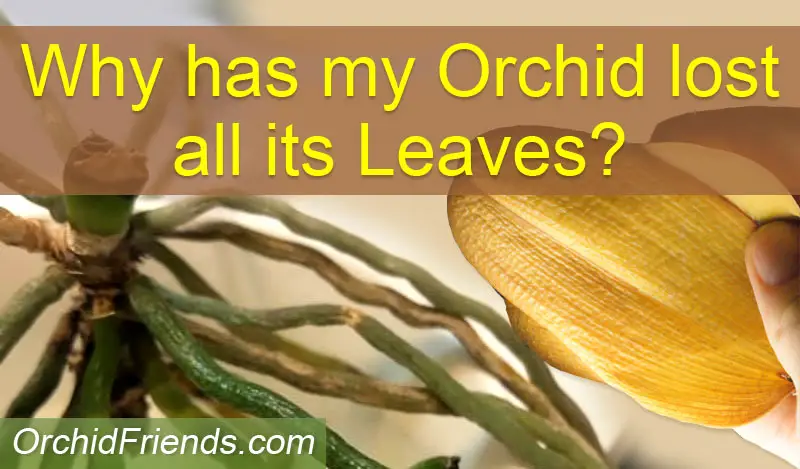
** This post is written and edited by a human being **
It brings a lot of joy to keep orchids – this is something I discovered early on with my very first Phalaenopsis orchid. It’s rewarding to see them grow new leaves and roots, and to blossom into beautiful flowers.
There’s something ‘zen’ about them. They quickly become something you love to do, and something that almost loves you in return – an exchange of good energy. A way of life!
But, as with most things in life, it’s not all dancing on roses. The more orchids you have, and the longer you have them, or sometimes even with your very first orchid, you will run into problems – like your orchid losing all its leaves! This kind of problem can quickly set a wave of panic and distress, understandably so!
So let’s explore this issue below, what might be causing it and what you can do about it.
So why has my orchid lost all its leaves? This can be caused by several different factors, like an advanced pest problem, root rot, crown rot, bacterial infections, viruses, dehydration, too much sun exposure, freezing, or even over-fertilizing.

Finding out what caused your orchid to drop all its leaves is the first step towards fixing this issue. Once you know what caused it, you can then take the necessary steps to either try to rescue your orchid or dispose of it.
It’s also important to detect the cause, so you can prevent this issue from happening again with your other orchids. That is why obstacles are, in fact, an important part of growing orchids—each time we are faced with a new problem, we come out of it as wiser orchid keepers!
Advanced pest problem 🐛
Detect your orchid; do you see any pests lurking around the crown or potting medium? Most pests are hard to see with bare eye, so use a magnifying glass. Look for anything that moves and even eggs! Some pests, like red spider mites, leave behind “track marks” when they eat plant tissue, so look for signs like that too.
I would advise you to pull the orchid out of its pot and remove all potting medium; inspect the roots. An orchid dropping all its leaves due to a pest problem means the infestation is already at an advanced level. In which case you have to take immediate action to either treat or dispose your orchid. Also check your other plants – pests can quickly spread, in which case you have an even bigger problem to tackle!
Root Rot
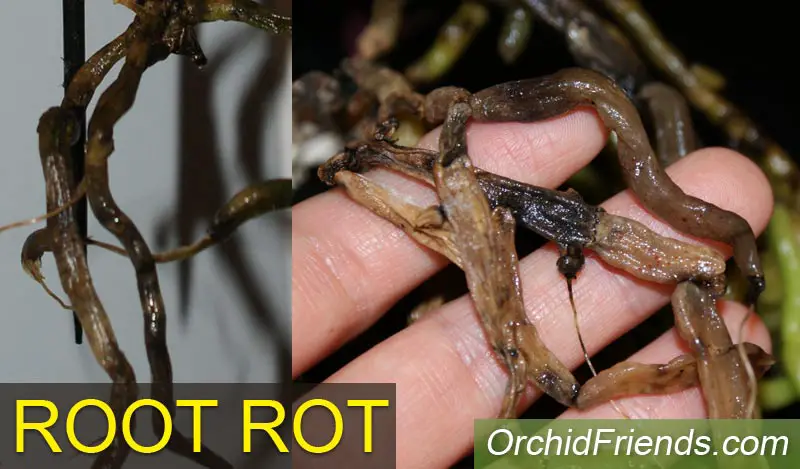
Remove all potting medium from your orchid and inspect the root system. Do the roots look discolored and mushy? When you touch them, does the ‘skin’ just peel off and you’re left with a small root string? If all the roots are like this, you’re dealing with a serious case of root rot.
Root rot is caused by too much watering and lack of good drainage inside the pot. This humidity builds up over time and starts to suffocate the roots. Phalaenopsis orchids are “epiphytes”, plants that grow in the air attached to tree trunks and other surfaces, so their roots need air to breathe! Therefore, a constantly wet orchid potting medium makes the roots rot, which will ultimately kill the orchid.
Crown Rot
It’s pretty quick and easy to find out if your orchid dropped all its leaves because of crown rot. Simply inspect the crown. (Crown is the middle section of the plant, where the new leaves grow from) Does it look black? If this is the case, you’re indeed dealing with crown rot!
This is a serious condition, and caused by water getting in the crown. It can start from just a small drop! Over time this moisture stuck in the crown starts to rot the plant tissue and spread. Soon the whole crown has turned black and all the leaves fall of.
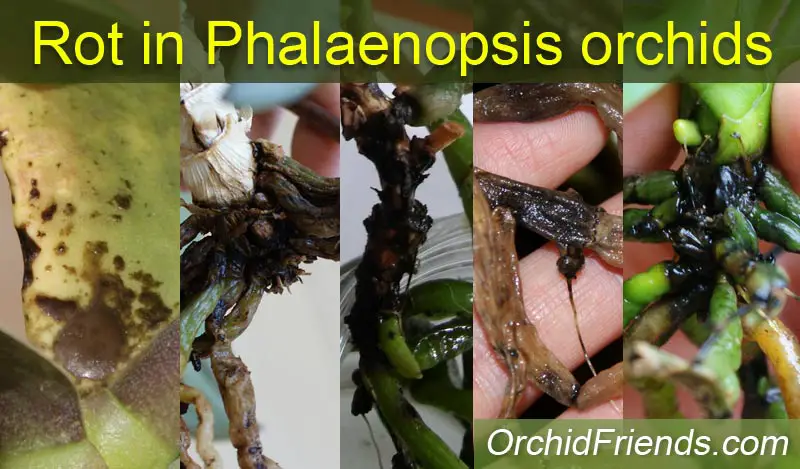
There is also collar rot and stem rot, which all show up as black coloring.
Bacterial infections and Viruses ☣️
It is possible for Phalaenopsis orchids to suffer from this kind of issues too. For example;
-Acidovorax bacteria causes Bacterial Brown Rot – this would show as brown spots on your orchid’s leaves, and will spread if not treated on time.
-Orchid Fleck Virus shows as chlorotic spots on the leaves – this looks like collapsed plant cells, and will keep spreading with time. ‘OF’ virus is believed to be transmitted by the false spider mite, which isn’t an uncommon pest to attack Phalaenopsis orchids.
To detect if your orchid dropped all its leaves due to bacterial or virus issues, inspect the leaves – do you see any discoloration, spots or unusual circles in them?
It’s important to always keep orchids separate from each other, to prevent any diseases from spreading from an orchid to orchid. You can of course have them standing next to each other, but just don’t let their leaves touch each other.
Wash your hands in-between handling different plants, and more importantly; remember to sterilize the scissors/pruners before using them to cut your orchids. If you use scissors/pruners on an orchid that has a virus, then move on to cut another orchid with those same scissors/pruners without sterilizing them – voilà, you’ve transferred the virus!
Dehydration
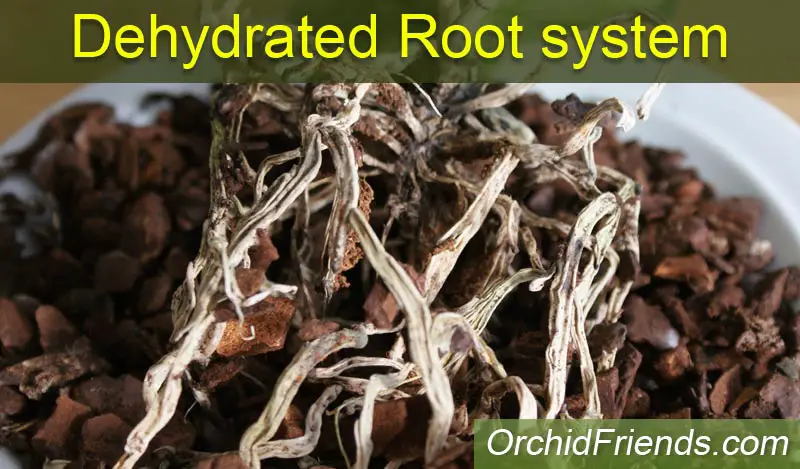
To find out if this is the reason why your orchid dropped all its leaves, remove all potting medium and inspect the roots. Are they dry and hard, visibly dehydrated with no sign of life anymore? This is one of the most common killers of Phalaenopsis orchids, and it’s caused by underwatering.
It’s not always your fault though – Phalaenopsis orchids can be struggling with dehydration already when you first bring them home. I can’t even tell you how many times I’ve unpotted a brand new orchid, only to discover its root system is already totally dried out! The plants get watered at the greenhouse, but during transport and even in most shops it’s a different case.
That’s why it’s always important to inspect the roots when buying a new orchid – just make sure you see some roots through the clear plastic pot, and that they look nice and healthy.
Sun Exposure ☀️
Even though Phalaenopsis orchids love and need a lot of good bright light, they’re very sensitive to heat. To find out if this is what you’re dealing with, you need to inspect the orchid’s leaves that fell off – I hope you saved them!
Heat damage causes death plant tissue, so the affected areas look burnt and dry. If your whole orchid was in direct hot sun, then the whole plant would turn dry and brittle. The leaves might be light brown/yellow in color, or even black – or a combination of both.
It’s okay to keep indoor orchids on the windowsill, but keep an eye on the souring temperatures during warmer seasons. If the sun gets too hot, then move the orchids further in the room to avoid getting sunburned.
Freezing ❄️
Too-cold temperatures can also kill your orchid. Cold damage normally shows as dark, watery areas in the leaves. This kind of damage can’t be reversed in the affected areas anymore, and the damaged leaves will ultimately fall off.
Cold damage can happen if the orchid experiences cold drafts or is kept in under 50F (10C) temperatures. If the weather has been colder lately where you live (and where you keep your orchids), then it could well be your orchid dropped all its leaves because of cold damage!

Over-Fertilizing
When giving plant fertilizer to your Phalaenopsis orchids, it’s important to follow the dosing instructions on the bottle. I’d even go as far as cutting down that amount to half, just to be on the safe side!
I know of several cases where people gave fertilizer to their orchids without reading the instructions. It ended up being too much, which killed the plants.
So if your orchid has dropped all its leaves, over-fertilizing can be the cause of it too. To know if this is the case with your orchid, think back; have you been freely pouring plant fertilizer to your orchids? Without ever even checking how much you’re supposed to give?
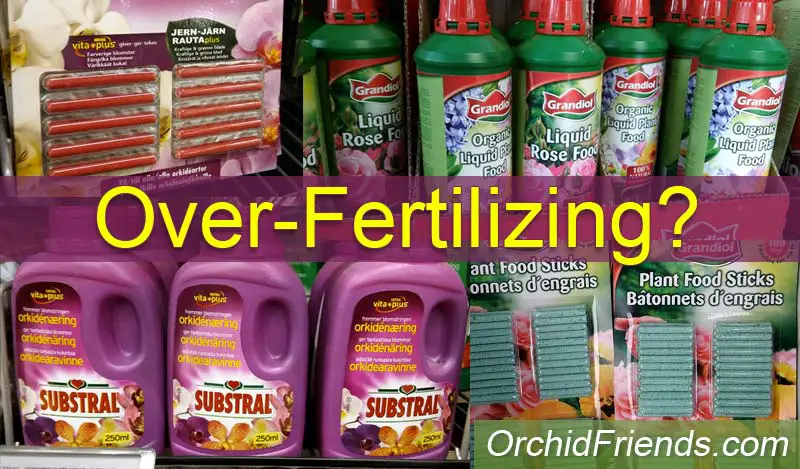
It’s okay to eyeball the amounts too, but only when you know what amounts are okay! Otherwise, do not take risks, because with fertilizers little goes a long way! And too much can kill your orchid.
Is an orchid dead when the leaves fall off? 💀
If your orchid has gone as far as dropping all its leaves, the chances to save it are slim. First of all, whatever the cause is, it must be already on an advanced level at this point.
Orchids don’t normally drop all their leaves over night. And if they do, it’s because the plant has been fighting something already for a longer time – you just didn’t notice it.
If the plant’s root system looks still good, you can keep caring for it and hope for the best. Sometimes the leafless plant can start to grow a new leaf or even a ‘keiki’ – a dying orchid’s SOS signal by cloning itself, which some people also refer to as the “orchid’s baby”.
However, if your plant’s root system is totally dead, then it’s a goner. No leaves + no roots = no point of return. You’d need one or the other to try to revive an orchid! So if even the roots are gone in addition to the fallen leaves – sorry, it’s time to say goodbye to your orchid. 😢
It’s important to always keep checking your orchids. Just look at the leaves and roots, even the flowers and buds. If you see anything out of the ordinary, then look further into it. Because a lot can happen before the orchid starts to show big serious signs! So it’s better to catch the problem when it’s still at an early stage – smaller problems are easier to tackle!
How to revive an orchid without leaves?
Okay, so let’s say your orchid dropped all its leaves but the roots are still nice and healthy. The first thing I’d advise you to do is to unpot the orchid. Clean the roots from old potting medium, and rinse with lukewarm water. Trim off any dry or mushy roots. Then spray the whole root system with Hydrogen Peroxide 3% – this disinfects the roots.
Next, you can either replant your orchid in fresh orchid potting medium. Water as usual, and add some mild fertilizer to give the orchid a boost. Wait and hope your orchid will start to grow new leaves!
Optionally, you can put the orchid to stand in a small container (glass, vase etc) with water in it. The water should come up to a quarter or third of the roots’ length. This method is called ‘water culture’. I use this method for orchids that are struggling. (You can read more about water-culture HERE) Once the plant has started to improve, I transfer the plant to bark potting medium.
The only thing to keep an eye on with water culture is the water level – the water will evaporate so add more water as needed. You can also add a drop of fertilizer in the water – just remember; less is more. It’s also fine to sometimes give the roots a “dry day” – meaning, you pour out the water, and let the roots dry for 1-3 days. Then add water again. (Dry and wet cycles)
I cannot guarantee you that your orchid WILL recover after dropping all its leaves, because so many factors play a part in it. The first question is; what caused the plant to drop all its leaves? In some cases it’s impossible to revive the orchid anymore, but in others it’s worth a try! It will acquire a lot of patience to try to revive it, so be prepared if that’s the route you choose. If you succeed it’s worth it in the end!
FINAL THOUGHTS
I hope this article has answered some of your questions about your orchid dropping all its leaves. I have experienced this nightmare a few times too, caused by crown rot and also false spider mite infestation. I was beside myself both times!
But it also taught me a lot – perhaps most importantly to always keep an eye on my orchids. If anything out of the ordinary appears on the plants, I now investigate it immediately.
Try to be three steps ahead, so you can prevent a catastrophe from happening!
On that note, thank you for reading. If you have any questions or comments, please leave them in the comment section below! Bye for now, orchid friends… 😊





Hi thanks for the good information. One of my orchids recently dropped all it’s leaves so this article was really helpful! Thanks! I have bookmarked your blog now. Amy 🙂
Hi Irena. Good reading, thank you. I live in Sweden and we don’t have so much information about these orchids here. My wife bought the first one 3 years ago and now we both love them! We must have over 20 already.
My flower dropped all the flowers. Mostly one by one. I had it in southern sun and moved to morning sun. Then it started to lose leaves. Not sure what to do now. Which sun is better? I’ll inspect roots and see if I think it can be saved.
Hi Marcie
Oh, sorry to hear about your orchid. Dropping flowers isn’t concerning per se, weather changes (hot sun, cold draft) can easily cause it. But the fact that now ALSO the leaves are starting to drop, worries me! By unpotting the orchid you’ll see how the roots and stem are doing – if they’re rotting, the plant can start to drop its leaves. (Remember, it’s normal for an orchid to drop one of the older leaves every now and then, but dropping multiple leaves is of concern)
South-facing window is OK during cooler seasons, but not when the sun is the strongest! This, of course, depends on what climate you live in. Other than that, East-facing window is normally safe.
Good luck with your orchid!